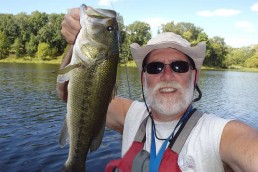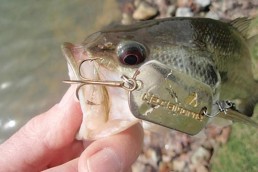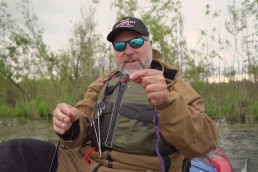The 20-minute Window: Topwater Bass at Day’s End
SHARE THIS POST
My son and I used to fish a shallow lake with extensive flats 5 feet deep, loaded with vegetation and largemouths. We fished topwater during the summer, typically arriving an hour before sunset to warm up, anticipating the action to come. My favorite plug was a Heddon Torpedo with a clear plastic body. As sunrays lingered on the water, the absence of color definition made the plug seem inconspicuous, which may have helped us catch a few before the bite really turned on.
Get familiar enough with what happens on one lake, and you may begin to generalize a pattern for other waters as well—go and apply your wisdom. I dubbed what we began to experience at our local lake “the 20-minute window,” when bass turn on and feed aggressively for a fairly short time during summer evenings. You want to be ready when it happens.
When exactly the blitzing ensued varied from outing to outing. Of course, the time of sunset progressively changes as summer lingers on, but the action never heated up at the same interval of time in relation to sunset itself. Hits increased just before sunset, one full half hour thereafter, or any other time between the minutes before sunset and sometime later in the gathering dusk—we never did well after dark, usually. Topwater bass fishing at night can be productive though, especially for the biggest bass, but if you want to strictly go night fishing, 3 a.m. is a better time than shortly after a sundown.
Recognizing “the window” prepares us for the peak feeding activity, and the bass rarely let us down. Why this happens, I don’t know, but I have read some university-led research. During times when light intensity changes—around sunset—bass see the fish forage better. In addition, since summer bass slow down to conserve calories while cold-blooded metabolism peaks in the warm water, they nevertheless need food to fuel that furnace. When they can take an advantage over meaty prey like large baitfish, the gain in caloric intake serves the daily need. Sight advantage means bass swim while looking upward to see forage fish silhouetted in the light coming through the surface. And a topwater plug is just the ticket, especially in clear water that allows bass full play in relation to light.
When we fish topwaters—whether on a lake, reservoir or river—bass respond for that short while to take all they can quickly. Our topwater experience around sunrise often finds big bass extremely shallow, assaulting plugs in as little as a foot of water. But for reasons I can’t ascertain, we’ve never noticed a pronounced feeding period. Maybe it’s just lack of experience on our part, but in any case, looking for the possibility of feeding binges helps you meet them when they happen.
Have at least a couple of rods apiece ready. This way, if you fish a bass-colored Rebel Pop-R and get curious about the Silver Heddon Torpedo on the other rod, you can just grab it. We all play favorites, and usually more than one.
Are you enjoying this post?
You can be among the first to get the latest info on where to go, what to use and how to use it!
Familiarity with plugs involves how to fish them. Any sort of lure is a pretty awkward imitation of real, living prey, no matter how lifelike the paint job. A current trend in thought on why lures catch fish suggests that they do no more than trigger aggressive impulses, since the complex sensory organs of gamefish—such as the lateral line—distinguish lures from anything their brains pattern as food. Most of us know that bass get conditioned to lures they see and sense in the water repeatedly. Watch how most anglers fish them and you’ll see the same generic retrieve, which is more or less casting a plug and reeling it back with a steady stop-and-go pattern. The way you play a lure, different than the way others do, distinguishes the presentation, compared to what bass get used to. That’s an advantage you need on pressured waters. And if you’re real good, you can impart a lot of life to a plastic plug, and it can’t hurt to do that.
Ponds offer classic evening feeding sprees.
Fred Matero with a nice bass he nailed in a weed pocket.
Rivers serve great topwater fishing in the evening.
MWO
SHARE THIS POST
Did you enjoy this post?
You can be among the first to get the latest info on where to go, what to use and how to use it!
Bruce Edward Litton
MidWest Outdoors works with more than 200 outdoor experts each year, who contribute articles based on their areas of expertise. MidWest Outdoors magazine offers more fishing and hunting articles than any other publication!



